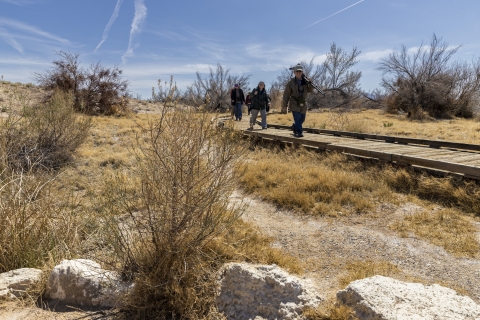You are walking in the desert. It is hot, scorching hot. You can’t remember how long you have been walking. The only things you know is your throat is growing increasingly dry and you are thirsty, really thirsty. Sand blows in your face. As you stumble along you have grown used to the mirage on the horizon playing tricks on you, so you don’t think the patch of green off to the right is real. Can it be real? Why not stagger along in that direction? As you get closer, the blurred image starts to take shape, revealing and unexpected sight, trees. Can it really be trees? You walk more confidently, quickly. As you get closer, you begin to hear the soothing sound of trickling water. Your heart swells with hope, as the sound grows louder and sweeter. Then, before your eyes, emerges a paradise in the midst of desolation.
Ash Meadows National Wildlife Refuge, managed by the U.S. Fish and Wildlife Service is the largest remaining oasis in the Mojave Desert, just outside of Pahrump, Nevada. At just under 24,000 acres, it isn’t the largest refuge, but as one of North America’s preeminent biodiversity hotspots, there is plenty to discover.
“Our recreation opportunities are as unique as Ash Meadows itself,” said Jennifer Heroux, Visitor Services manager. “Where else can you hike, bird and photograph among some of the rarest species in the world? Our oasis welcomes all kinds of visitors, so we also offer education, interpretation and hunting on the refuge. It is a place that people remember and return to again and again”
The boardwalk to Crystal Spring, just out the back door of the visitor center, is one-mile and is wheelchair accessible with easy access to restrooms and a covered picnic area. Along the path is the refuge’s largest spring, groves of mesquite and ash trees, and where unique species such as pupfish are found.
Two additional interpretive areas, located at Longstreet Spring and Point-of-Rocks, provide other unique opportunities for wildlife viewing including pupfish, nature exploration and quiet solitude. These sites both include wheelchair-accessible boardwalks to unique spring habitats and restrooms. The Point-of-Rocks area also includes shaded picnic tables.
If you would rather take a drive, an auto tour is a good option any time of year. Each season provides opportunities for wildlife observations and surprising landscapes.
“I’d say we're best known for things like birding and wildlife viewing and there isn't a lot of Urban Development nearby,” said Leah Simantel, ecological restoration specialist for the refuge. “It's a quiet landscape and kind of a haven for wildlife. In addition to viewing opportunities, you can bike along the roadside and one of the projects slated for the next couple of years is installation of a new backcountry trail in the Upper Carson Slough. So, there's going to be an increase in hiking opportunities.”
Bighorn sheep sightings are not uncommon at Point-of-Rocks. There are also many species of birds, lizards and plants found on Ash Meadows, which has the highest concentration of endemic species in the United States. There are also multiple antique cabins located on the refuge, including one that famed gunslinger Jack Longstreet built and used to hide from authorities in the late 1800s.
“We have lots of really great opportunities for visitors, but sometimes we’re a little under the radar,” said Mike Bower, refuge manager at Ash Meadows. “But we really love to see our neighboring communities get out and experience the solitude and the unique environment of Ash Meadows. We also have a wonderful visitor center that has just unlimited opportunities for environmental education and learning about this unique ecosystem.”
The 11,000 square foot visitor center includes several interpretive centers and displays, a bookstore, multiple exhibits and is open to the public from 9 a.m. to 4:30 p.m. Staff and volunteers assist nearly 50,000 visitors a year at the visitor center, and many people take a break in the auditorium to watch the stunning refuge film.
“We love to connect with our local schools in the neighboring communities and host school groups,” said Bower. “I can't think of a higher priority than connecting the next generation with some of these amazing, special places.”

